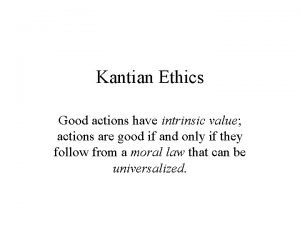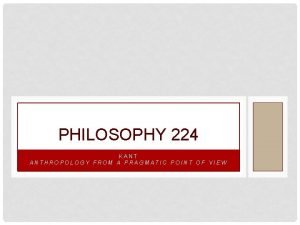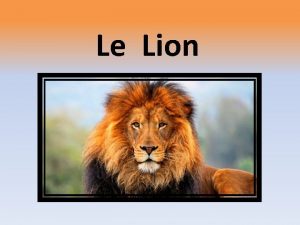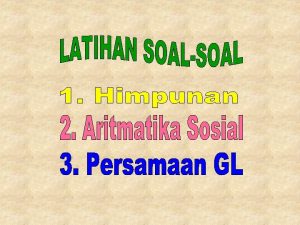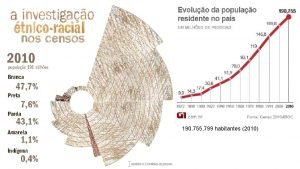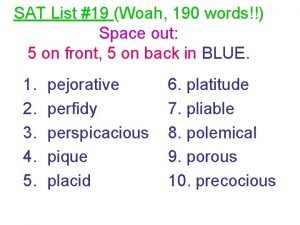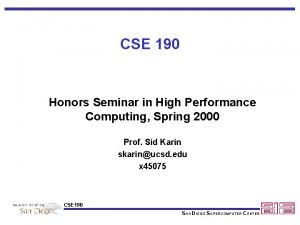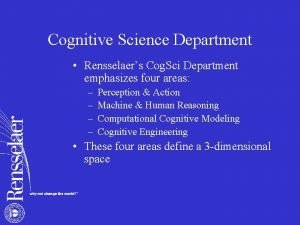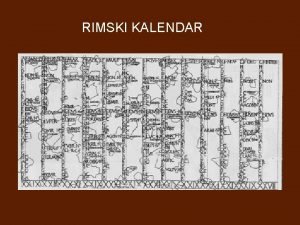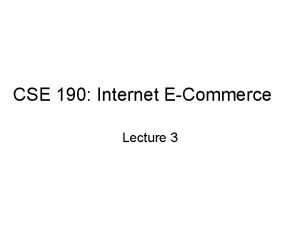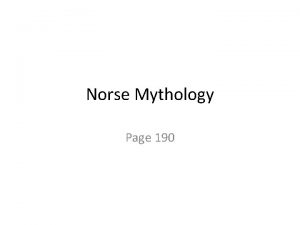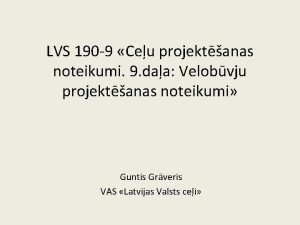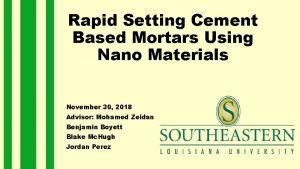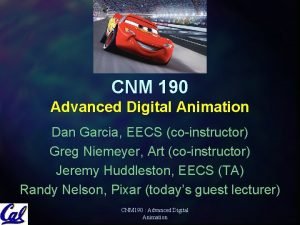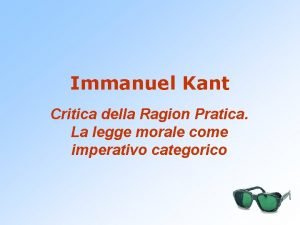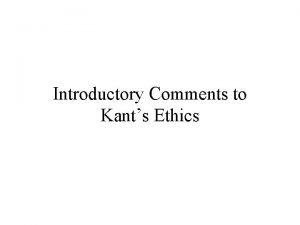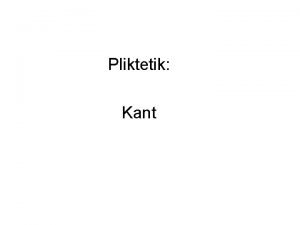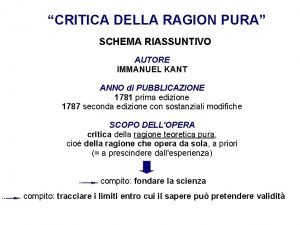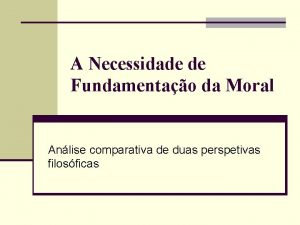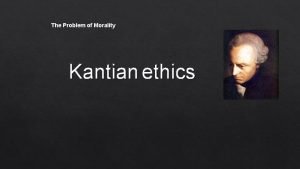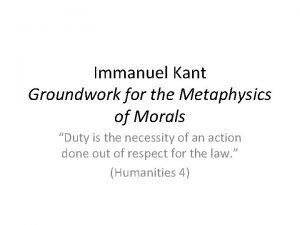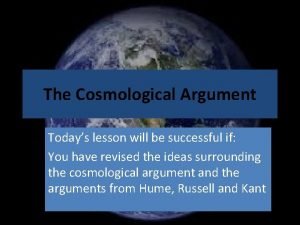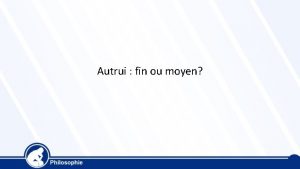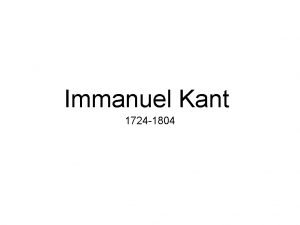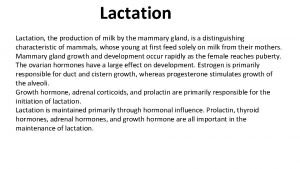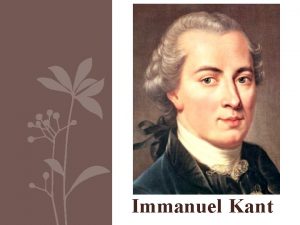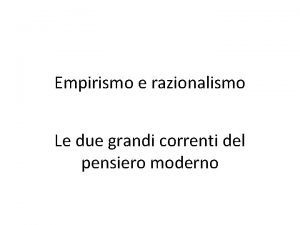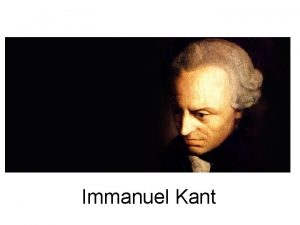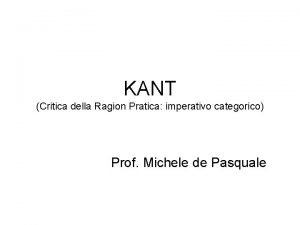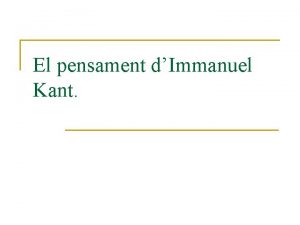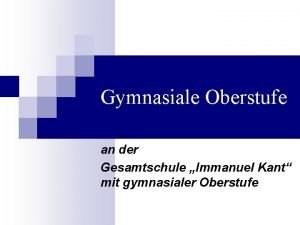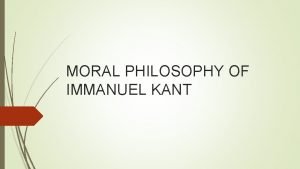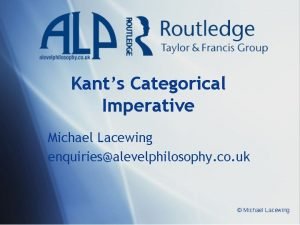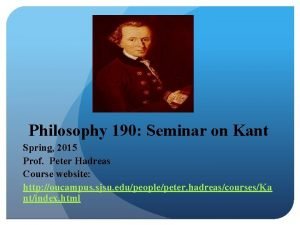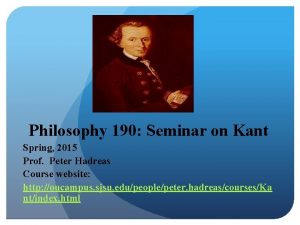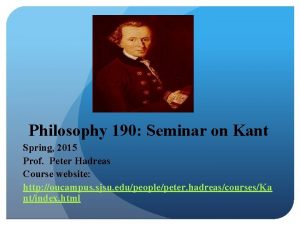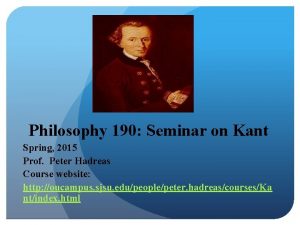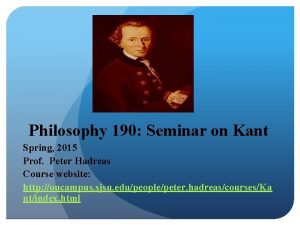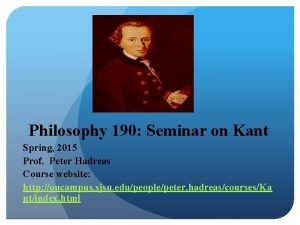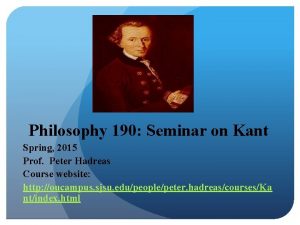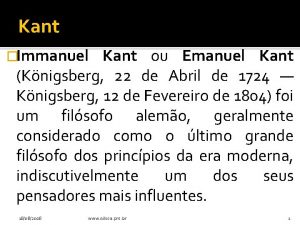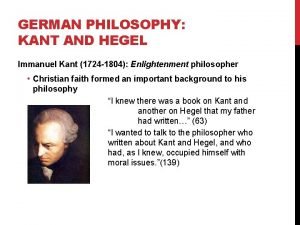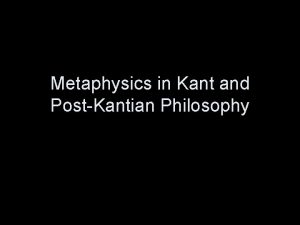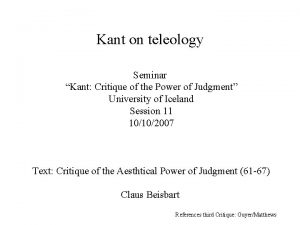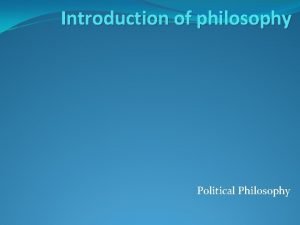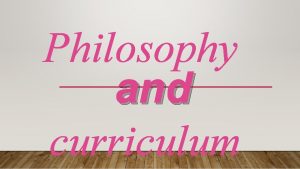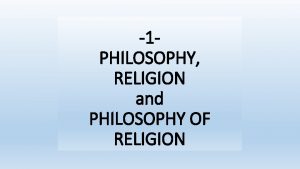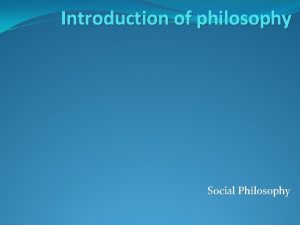Philosophy 190 Seminar on Kant Spring 2015 Prof











![Kant on Newton and Leibniz on Time and Space “Those [Newton and his followers], Kant on Newton and Leibniz on Time and Space “Those [Newton and his followers],](https://slidetodoc.com/presentation_image_h2/5859bd87ed41af5c7418b53d64378af3/image-12.jpg)


![Kant on Space The Transcendental Aesthetic, First Section, On Space [Von dem Raume] (pp. Kant on Space The Transcendental Aesthetic, First Section, On Space [Von dem Raume] (pp.](https://slidetodoc.com/presentation_image_h2/5859bd87ed41af5c7418b53d64378af3/image-15.jpg)






![Kant on Time The Transcendental Aesthetic, Second Section, On Time [Von der Zeit] (pp. Kant on Time The Transcendental Aesthetic, Second Section, On Time [Von der Zeit] (pp.](https://slidetodoc.com/presentation_image_h2/5859bd87ed41af5c7418b53d64378af3/image-22.jpg)

![Proofs that time is particular. 3. "It [Time] has only one dimension: different times Proofs that time is particular. 3. "It [Time] has only one dimension: different times](https://slidetodoc.com/presentation_image_h2/5859bd87ed41af5c7418b53d64378af3/image-24.jpg)













![An Outrageous Inconsistency in the Critique of Pure Reason? [continued from previous slide] “. An Outrageous Inconsistency in the Critique of Pure Reason? [continued from previous slide] “.](https://slidetodoc.com/presentation_image_h2/5859bd87ed41af5c7418b53d64378af3/image-38.jpg)






![Kantian Scholar’s, Claude Piché’s, Answer to the Alleged Inconsistency [continued from previous slide] “Following Kantian Scholar’s, Claude Piché’s, Answer to the Alleged Inconsistency [continued from previous slide] “Following](https://slidetodoc.com/presentation_image_h2/5859bd87ed41af5c7418b53d64378af3/image-45.jpg)
![Kantian Scholar’s, Claude Piché’s, Answer to the Alleged Inconsistency [continued from previous slide] “Thus, Kantian Scholar’s, Claude Piché’s, Answer to the Alleged Inconsistency [continued from previous slide] “Thus,](https://slidetodoc.com/presentation_image_h2/5859bd87ed41af5c7418b53d64378af3/image-46.jpg)

- Slides: 47

Philosophy 190: Seminar on Kant Spring, 2015 Prof. Peter Hadreas Course website: http: //oucampus. sjsu. edu/people/peter. hadreas/courses/Ka nt/index. html

The Transcendental Aesthetic, as published in the Second Edition of the CPR (pp. 172 -192).

Two questions hang over the transcendental aesthetic: 1. How is it that mathematics is a priori synthetic, i. e. , consists in necessary judgments? 2. How is it that mathematics, although abstract, applies to concrete experience?

'Intuitions’ and 'Concepts' are both 'Cognitions. ' For Kant the concept of intuition is extremely abstract. Intuition (Anschauung) is distinct from perception which presupposes concepts and intuitions. Also intuition is more abstract than sensibility (Sinnlichkeit). Kant, accordingly, discusses 'intellectual intuition’ (pp. 190 -2).

“The mutual dependence of intuition and concepts is an absolutely fundamental proposition of Kant's epistemology. ” 1 “Without sensibility no object [Gegenstand] would be given to us, and without understanding [Verstand] none would be thought. Thoughts without content are empty, intuitions [Anschauungen] without concepts are blind. It is thus just as necessary to make the mind’s concepts sensible (i. e. , to add an object [Gegenstand] to them in intuition), as it is to make its intuitions understandable (i. e. , to bring them under concepts). Further, these two faculties or capacities cannot exchange their functions. The understanding is not capable of intuiting anything and the senses are not capable of thinking anything. ” (A 51/B 75, trans. : p. 193 -4) 1. Gardner, Sebastian, Kant and the Critique of Pure Reason, (London/New York: Routledge, 1999), p. 89.

Kant Sets Out Basic Terms for an Analysis of Sense-Experience “The effect of an object on the capacity for representation, insofar as we are affected by it, is sensation. That intuition which is related to the object through sensation is called empirical. The undetermined object of an empirical intuition is called appearance [Anschauung}. I call that in the appearance which corresponds to sensation its matter, but that which allows the manifold of appearance to be ordered in certain relations I call the form of appearance. Since that within which the sensations can alone be ordered and placed in a certain form cannot itself be in turn sensation, the matter of all appearance is only given to us a posteriori, but its form must all lie ready for it in the mind a priori, and can therefore be considered separately from all sensation. ” (p. 172)

Kant Sets Out Basic Terms for an Analysis of Sense-Experience “I call representations pure (in the transcendental sense) in which nothing is to be encountered that belongs to sensation. Accordingly the pure form of sensible intuitions in general is to be encountered in the mind a priori, wherein all of the manifold of appearances is intuited in certain relations. This pure form of sensibility itself is also called pure intuition. So if I separate from the representation of a body that which the understanding thinks about it, such as substance, force, divisibility, etc. , as well as that which belongs to sensation, such as impenetrability, hardness, color, etc. , something from this empirical intuition is still left for me, namely extension and form. These belong to the pure intuition, which occurs a priori, even without an actual object of the senses or sensation, as a mere form of sensibility in the mind. ” (p. 173, A 21/B 35)

Kant’s Picture of Sense-Experience Objects (Gegenstände) (Objekten) Sensibility (Sinnlichkeit) a capacity Representations (Vorstellungen) passive, receptive Appearances Intuitions, particulars (Erscheinungen) (Anschaungen) Undetermined if from sensibility: Unbestimmt may include a priori syntheses Experience (Erfahrung) Concepts (Begriffen) generalities, applied by Understanding

Leibniz on Time and Space G. W. Leibniz (1646 – 1716) “space. . . is something merely relative, as time is. . . ' that it is 'an order of coexistences as time is an order of successions. ' Leibniz thought that to understand space and time 'to be a substance, or at least an absolute being' is 'a fancy. ' (Third letter to Clarke, §§ 4, 5. )

Newton on Space Isaac Newton (1642 – 1726/7) "Absolute space, in its own nature, without relation to anything external, remains always similar and immovable. Relative space is some movable dimension or measure of the absolute spaces; which our senses determine by its position to bodies; and which is commonly taken for immovable space; such as the dimension of a subterraneous, an aerial or celestial space, determined by its position in respect of the earth. " (Newton, Sir Issac, Mathematical Principles of Natural Philosophy, ed. Cajori, (Chicago: Encyclopedia Brittanica, Inc. , Great Books of the Western World, 1952), p. 8.

Newton on Time Isaac Newton (1642 – 1726/7) “Absolute, true, and mathematical time, of itself, and from its own nature, flows equably without relation to anything external, and by another name is called duration: relative, apparent, and common time, is some sensible and external (whether accurate or unequable) measure of duration by the means of motion, which is commonly used itself of true time, such as an hour, a day, a month, a year" (Newton, Ibid. )
![Kant on Newton and Leibniz on Time and Space Those Newton and his followers Kant on Newton and Leibniz on Time and Space “Those [Newton and his followers],](https://slidetodoc.com/presentation_image_h2/5859bd87ed41af5c7418b53d64378af3/image-12.jpg)
Kant on Newton and Leibniz on Time and Space “Those [Newton and his followers], however, who assert the absolute reality of space and time, whether they assume it to be subsisting or only inhering, must themselves come into conflict with the principles of experience. For if they decide in favor of the first (which is generally the position of the mathematical investigators of nature), then they must assume two eternal and infinite self-subsisting non-entities (space and time), which exist (yet without there being anything real) only in order to comprehend everything real within themselves. ” (pp. 183 -4)

Kant on Newton and Leibniz on Time and Space “If they adopt the second position (as do some metaphysicians of nature) [Leibniz, Wolff], and hold space and time to be relations of appearances (next to or successive to one another) that are abstracted from experience though confusedly represented in this abstraction, then they must dispute the validity or at least the apodictic certainty of a priori mathematical doctrines in regard to real things (e. g. , in space), since this certainty does not occur a posteriori, and on this view the a priori concepts of space and time are only creatures of the imagination, the origin of which must really be sought in experience, out of whose abstracted relations imagination has made something that, to be sure, contains what is general in them but that cannot occur without the restrictions that nature has attached to them. ” (p. 184)

Heidegger on Space M. Heidegger (1889 – 1976)) “Only things that are locations in this manner allow for spaces. What the word space, Raum, designates is said by its ancient meaning, Raum, Rum, means a place cleared or freed for settlement and lodging. ” [cf. English: ‘Room’]. “Is there room for me to live. ”. , . . “Accordingly, spaces receive their essential being from locations and not from ‘space. ’” Heidegger, Martin, “Building Dwelling Thinking, ” Basic Writings, p. 332:
![Kant on Space The Transcendental Aesthetic First Section On Space Von dem Raume pp Kant on Space The Transcendental Aesthetic, First Section, On Space [Von dem Raume] (pp.](https://slidetodoc.com/presentation_image_h2/5859bd87ed41af5c7418b53d64378af3/image-15.jpg)
Kant on Space The Transcendental Aesthetic, First Section, On Space [Von dem Raume] (pp. 174 -8).

Proofs that the character of space is a priori. 1. Space is needed to think objects in relation to each other. "Space is not an empirical concept which has been derived from outer experiences. For in order that certain sensations to be related to something outside me (i. e. , to something in another region of space from that in which I find myself) thus in order for me to represent them as outside <and next to> one another, thus not merely as different, but as in different places, the representation of space must already be their ground. ” (p. 1745)

Proofs that the character of space is a priori. 2. "One can never represent that there is no space, although one can very well think that there are no objects to be encountered in it. ” (p. 175) Note: Kantian scholars often have found this second argument the more compelling the first. See for example, Körner, S. , Kant, (London: Penguin Books, 1955), p. 34. In Körner’s words, this second argument is "the more convincing of the two. "

Proofs that space is particular 3. "Space is not a discursive or, as is said, general concept of relations of things in general, but a pure intuition. " Our imagination, Kant believes, can picture only a single space, of which all spaces which can be pictured are parts. "It [space] is essentially single. ” (p. 175)

Proofs that space is particular 4. Space can be split up into parts in a way in which only particulars, and not also general notions, can be divided. Space therefore is also a particular. Kant says (p. 175) that a concept contains a number of representations under itself. i. e. there may be an infinite number of horses. But space contains an infinite number of representations within itself. (p. 175) Recall that intuitions are singular and given. They are not abstracted.

§ 3. The transcendental exposition of the concept of space. (p. 176) Since space is an a priori particular, judgments based, i. e. geometrical judgments, on it, remain the product of synthetic a priori reasoning. This explains why judgments of geometry are necessary and universal. (p. 176) But what of alternative geometries built on non-traditional interpretations of Euclid’s fifth postulate, i. e. non Euclidean geometries, such as hyperbolic geometry, elliptic geometry and non-metric geometries? They are necessary and universal but are they a priori synthetic?

Is Space Real? It is empirically real, but transcendentally ideal Space is a form of the sensibility according to which we perceive the world. But, the form is subjective. "We can accordingly speak of space, extended beings, and so on, only from the human standpoint. ” (p. 177) "For we cannot judge at all whether the intuitions of other thinking beings are bound to the same conditions as those which limit our intuition and that are universally valid for us. " (p. 177)
![Kant on Time The Transcendental Aesthetic Second Section On Time Von der Zeit pp Kant on Time The Transcendental Aesthetic, Second Section, On Time [Von der Zeit] (pp.](https://slidetodoc.com/presentation_image_h2/5859bd87ed41af5c7418b53d64378af3/image-22.jpg)
Kant on Time The Transcendental Aesthetic, Second Section, On Time [Von der Zeit] (pp. 178 -192).

Proofs that time is experienced a priori. 1. "Only under its presupposition can one represent that several things exist at one and the same time (simultaneously) or in different times (successively). ” (p. 178) 2. "Time is a necessary representation that grounds all intuitions. In regard to appearance in general one cannot remove time, though one can very well take the appearances from time. Time is therefore given a priori. In it alone is all actuality of appearances possible. The latter could all disappear, but time itself (as the universal condition of their possibility) cannot be removed” (p. 178)
![Proofs that time is particular 3 It Time has only one dimension different times Proofs that time is particular. 3. "It [Time] has only one dimension: different times](https://slidetodoc.com/presentation_image_h2/5859bd87ed41af5c7418b53d64378af3/image-24.jpg)
Proofs that time is particular. 3. "It [Time] has only one dimension: different times are not simultaneous but successive just as difference spaces are not successive but simultaneous. " So, since there is one time, and it is given, it is a particular, an indication that it is an intuition. (p. 179) 4. "Further, the proposition that different times cannot be simultaneous is not to be derived from a general concept. The proposition is synthetic, and cannot arise from concepts alone. ” (p. 179)

Proofs that time is particular 5. “The infinitude of time signifies nothing more than that every determinate magnitude of time is only possible through limitations of a single time grounding it. The original representation time must therefore be given as unlimited. But where the parts themselves and every magnitude of an object can be determinately represented only through limitation, there the entire representation cannot be given through concepts, for they contain only partial representations» , but immediate intuition must ground them. ” (p. 179)

Jorge Luis Borges 1899 – 1986 "El Jardín de senderos que se bifurcan” a short story by Argentine writer and poet, Jorge Luis Borges, published in 1941. English title: “Garden of Forking Paths. ”

From the “Garden of Forking Paths. ” 1 “. . . I have translated the entire work: it is clear to me that not once does he employ the word ‘time. ’ The explanation is obvious: The Garden of Forking Paths is an incomplete but not false image of the universe as Ts’ui Pên [the narrator, Dr. Yu Tsun’s ancestor] conceived it. In contrast to Newton and Schopenhauer, your ancestor did not believe in absolute time. He believed in an infinite series of times, in a growing, dizzying net of divergent, convergent and parallel times. This network of times which approached one another , forked, broke off, or were unaware of each other centuries, embraces all possibilities of time. ” 1. Borges, Jorge, Labyrinths, “The Garden of Forking Paths, (New York: New Directions, 1964) p. 28.

§ 6. Conclusions from these concepts (pp. 180 ff. ) As in the case with space, Kant declares that time is empirically real, i. e. , if we suppose that there is actually succession and simultaneity in the world, then time is real. But he disputes that we are justified in assigning time ‘absolute’ reality. “Such properties, which pertain to tings in themselves can never be given to us through the senses. ” We cannot know this. We must hold that time is transcendentally ideal. (p. 182)

How Space and Time are Empirical Real but Transcendentally Ideal: Kant’s Examples “We ordinarily distinguish quite well between that which is essentially attached to the intuition of appearances, and is valid for every human sense in general, and that which pertains to them only contingently because it is not valid for the relation of sensibility in general but only for a particular situation or organization of this or that sense. And thus one calls the first cognition one that represents the object in itself, but the second one only its appearance. ” p. 186 [continues]

How Space and Time are Empirical Real but Transcendentally Ideal: Kant’s Examples “. . Thus, we would certainly call a rainbow a mere appearance in a sun-shower, but would call this rain the thing in itself, and this is correct, as long as we understand the latter concept in a merely physical sense, as that which in universal experience and all different positions relative to the senses is always determined thus and not otherwise in intuition. But if we consider this empirical object in general and, without turning to its agreement with every human sense, . . . [continues, p. 187)

How Space and Time are Empirical Real but Transcendentally Ideal: Kant’s Examples [continued from previous slide] “ask whether it (not the raindrops, since these, as appearances, are already empirical objects) represents an object in itself, then the question of the relation of the representation to the object is transcendental, and not only these drops are mere appearances, but even their round form, indeed even the space through which they fall are nothing in themselves, but only mere modifications or foundations of our sensible intuition; the transcendental object, however, remains unknown to us. (p. 186)

Difference of ‘Outer’ and ‘Inner’ Sense’ “By means of outer sense (a property of our mind) we represent to ourselves objects as outside us, and all as in space. In space their shape, magnitude, and relation to one another is determined, or determinable. Inner sense, by means of which the mind intuits itself, or its inner state, gives, to be sure, no intuition of the soul itself, as an object; yet it is still a determinate form, under which the intuition of its inner state is alone possible, so that everything that belongs to the inner determinations is represented in relations of time. Time can no more be intuited externally than space can be intuited as something in us. (p. 174)

To Say Sensibility is Founded on Appearances is Not to Say it is an Illusion. “If I say: in space and time intuition represents both outer objects as well as the self-intuition of the mind as each affects our senses, i. e. , as it appears, that is not to say that these objects would be a mere illusion. For in the appearance the objects/ indeed even properties that we attribute to them, are always regarded as something really given, only insofar as this property depends only on the kind of intuition of the subject in the relation of the given object to it then this object as appearance is to be distinguished from itself as object in itself. ” (p. 190)

Theodor W. Adorno (1903 -1969)

Adorno on the Organization of the Critique of Pure Reason “. . . Although of course that chapter [the Schematism 1] is not situated where it really belongs, which is in fact between the Aesthetic and the Logic. The is because it makes clear that there is a sort of neutral zone between Aesthetic and Logic, namely the element of time which is actually the scheme in accordance with which the objects of intuition are simultaneously defined as potential objects of the intellect. . . ” Adorno, Theodor W. , Kant’s Critique of Pure Reason, T. Tiedemann, edit, Livingstone, trans. (Stanford: Stanford U. Press, 2001), p. 224. 1. Adorno is referring to the whole of Book II of Division One of CPR. “The Analytic of Principles”, Book II of Division One should precede Book I, “The Analytic of Concepts. ”

Critique of Pure Reason Prefaces Introduction First Part Trans. Aesthetic Transcenden tal Doctrine of Elements Second Part Trans. Logic Division Two: Trans. Dialectic Division One: Trans. Analytic Book I: Analytic of Concepts Transcenden tal Method Book II: Analytic of Principles Introduction Book I: Concepts of Pure Reason Book II: The dialectical inferences of pure reason

An Outrageous Inconsistency in the Critique of Pure Reason? “But we can go even further than this. The Critique of Pure Reason has always been criticized. . . For a particular kind of contradiction. The best known of these is this: on the one hand, Kant insists that his starting point is always what is immediately present to us, what is ‘given’, and he wishes to preclude all transcendent premises. At the same time he speaks of ‘affections’, that is, of the fact that what is immediately given to me, my sense data, originates in an external; world that affects me. This inconsistency is so straightforward that it would be crystal-clear to a child. You will probably realize – and this is much more interesting – that this particvular contradfction exists for a very good reason. ” Adorno, Theodor W. , Kant’s Critique of Pure Reason, T. Tiedemann, edit, Livingstone, trans. (Stanford: Stanford U. Press, 2001), p. 67.
![An Outrageous Inconsistency in the Critique of Pure Reason continued from previous slide An Outrageous Inconsistency in the Critique of Pure Reason? [continued from previous slide] “.](https://slidetodoc.com/presentation_image_h2/5859bd87ed41af5c7418b53d64378af3/image-38.jpg)
An Outrageous Inconsistency in the Critique of Pure Reason? [continued from previous slide] “. . . Kant prefers to accept the contradiction contained in asserting, on the one hand, that we know absolutely nothing about things-in-themselves; things are something that we constitute that we bring into existence with the aid of the categories. On the other hand, it is claimed that our affections arise from things in themselves, for only in that way can his theory of knowledge introduce the notion of the non-identical – that is, the element that is more than just mind or reason. ” Adorno, Ibid. , p. 67.

The Inconsistency Would Seem to Appear at the Beginning of the Transcendental Aesthetic, Among Many Other Places in the CPR. The Transcendental Doctrine of Elements, First Part, The Transcendental Aesthetic <B>: “The capacity (receptivity) to acquire representations through the way in which we are affected [affieirt werden] by objects is called sensibility. ” (p. 172)

The Inconsistency Would Seem to Appear at Many Places in the CPR: Another One of the Many “The transcendental concept of appearances in space, on the contrary, is a critical reminder that absolutely nothing intuited in space is a thing in itself, that space is not a form that is proper to anything in itself, but rather that objects in themselves are not known to us at all, and that we call outer objects are nothing other than mere representations of our sensibility, whose form is space, but whose true correlate, i. e. , the thing in itself, is not and cannot be cognized through them, but also is never asked after in experience. ” (pp. 161 -2, A 30/B 45)

Friedrich Heinrich Jacobi (1743 -1819) German philosopher, literary figure, socialite, notable for popularizing the term ‘nihilism. ’

“Perhaps the most intriguing single comment made about transcendental idealism is the famous remark of Kant’s contemporary Jacobi that, year after year, he had been forced in confusion to recommence the Critique because he had found himself unable to enter into the system of Kantian philosophy without the presupposition of the thing in itself, and yet, with that presupposition, unable to remain within it. ” 1 1. Gardner, Sebastian, Kant and the Critique of Pure Reason, (London/New York: Routledge, 1999), p. 269.

Claude Piché Professor of Philosophy, Specialization: Modern German Philosophy, University of Montreal

Kantian Scholar’s, Claude Piché’s, 1 Answer to the Alleged Inconsistency “In explaining affection, and sensation -- its effect -- in terms of the thing in itself, Kant does not intend to establish any knowledge about the type of causality at work nor does he try to determine the correlate of appearance, beyond saying that it is ‘heterogeneous’ 2 and indeterminate, that is, a ‘mere something’ (A 277/B 333) which is definitively out of reach of our knowledge. ” 1. Claude Piché is a Professor in the Philosophy Department at Université de Montréal, Montreal, QC. The quotes are from his paper, “Kant and the Problem of Affection, ” that appeared in The Canadian Journal of Continental Philosophy 8 (2): 275 -297 (2004). It is available online: http: //mapageweb. umontreal. ca/lepagef/dept/cahiers/Piche_KA NT. pdf 2. Prolegomena, § 57, AK, IV, 355.
![Kantian Scholars Claude Pichés Answer to the Alleged Inconsistency continued from previous slide Following Kantian Scholar’s, Claude Piché’s, Answer to the Alleged Inconsistency [continued from previous slide] “Following](https://slidetodoc.com/presentation_image_h2/5859bd87ed41af5c7418b53d64378af3/image-45.jpg)
Kantian Scholar’s, Claude Piché’s, Answer to the Alleged Inconsistency [continued from previous slide] “Following the principle of causality in its empirical employment which states that ‘everything that happens, that is, begins to be, presupposes something upon which it follows according to a rule’ (A 189), Kant refuses, using the category of causality for the thing in itself, to specify the ‘rule’ or the kind of causal action involved and to determine the essence of the acting cause. ”
![Kantian Scholars Claude Pichés Answer to the Alleged Inconsistency continued from previous slide Thus Kantian Scholar’s, Claude Piché’s, Answer to the Alleged Inconsistency [continued from previous slide] “Thus,](https://slidetodoc.com/presentation_image_h2/5859bd87ed41af5c7418b53d64378af3/image-46.jpg)
Kantian Scholar’s, Claude Piché’s, Answer to the Alleged Inconsistency [continued from previous slide] “Thus, when he employs the category of causality for the thing in itself in the Critique of Pure Reason, it is clear that he does not exceed in any way the very modest claims attached to a transcendental usage. ‘The merely transcendental employment of the categories is, therefore, really no employment at all 'for the knowing of anything’: Nachträge, CXXVII, 1 and has no determinate object, not even one that is determinable in its mere form. " (A 247 -8/B 304) 1. The Akademie edition’s Vorarbeiten und Nachträge (Preliminary Studies and Supplementary Entries) is part of Nachlaß (Posthumous Writings) as published in the Akademie Edition.

Slides #1, 3, 4, 5, Portrait of Immanuel Kant in mid-life: http: //www. lancaster. ac. uk/users/philosophy/courses/100/Kant 003. jpg Slide # 10, portrait of Leibniz: http: //en. wikipedia. org/wiki/Gottfried_Wilhelm_Leibniz#mediaviewer/File: Gottfried_W ilhelm_von_Leibniz. jpg slide #13: photograsph of. Martin Heidegger: http: //en. wikipedia. org/wiki/Martin_Heidegger#mediaviewer/File: Heidegger_4_%2819 60%29_cropped. jpg Slide #25: Photograph of Borges: http: //en. wikipedia. org/wiki/Jorge_Luis_Borges#mediaviewer/File: Jorge_Luis_Borges_ 1951, _by_Grete_Stern. jpg Slide #25, Photograph of Borges story, El Jardнn de senderos que se bifurcan: http: //en. wikipedia. org/wiki/The_Garden_of_Forking_Paths#mediaviewer/File: El. Jard% C 3%ADn. De. Senderos. Que. Se. Bifurcan. jpg Slide #35: Photograph of Theodor adorno: http: //maverickphilosopher. typepad. com/maverick_philosopher/adorno/ Slide #41: portrait of Jacobi: http: //en. wikipedia. org/wiki/Friedrich_Heinrich_Jacobi#mediaviewer/File: FH_Jacobi. jp g Slide #41: Photograph of Claude Piché ; https: //www. google. com/search? q=Claude+Pic%C 3%A 9%E 2%80%99 s&biw
 Kant moral philosophy
Kant moral philosophy Example of kantianism
Example of kantianism Immanuel kant philosophical view of self
Immanuel kant philosophical view of self Spring break 2015
Spring break 2015 Kim ki duk summer fall winter spring
Kim ki duk summer fall winter spring Spring what months
Spring what months Lion poids 190 kg
Lion poids 190 kg If a small motor does 520 j
If a small motor does 520 j S=bilangan asli
S=bilangan asli 10 % de 190 755 799
10 % de 190 755 799 190 words
190 words Telescience museum
Telescience museum Gefma richtlinie 190
Gefma richtlinie 190 Me 190 sjsu
Me 190 sjsu Vertical milling machine cnc
Vertical milling machine cnc Da 2823
Da 2823 Cogsci 190
Cogsci 190 ರೋಮನ್ ಅಂಕಿಗಳು
ರೋಮನ್ ಅಂಕಿಗಳು Cse 190
Cse 190 Ginnungagap
Ginnungagap Mk noteikumi 190
Mk noteikumi 190 Adva 190
Adva 190 Cnm 190
Cnm 190 190 vauxhall bridge road mental health
190 vauxhall bridge road mental health Critica della ragion pratica slide
Critica della ragion pratica slide Kant first categorical imperative
Kant first categorical imperative Kant vita
Kant vita Pliktetik
Pliktetik Immanuel kant
Immanuel kant Kant rivoluzione francese
Kant rivoluzione francese Schema critica della ragion pura
Schema critica della ragion pura Kant revolução francesa
Kant revolução francesa Hypothetical imperative
Hypothetical imperative What is the categorical imperative
What is the categorical imperative Kant's criticism of cosmological argument
Kant's criticism of cosmological argument Maximas kantianas
Maximas kantianas Kant agis de telle sorte que tu traites
Kant agis de telle sorte que tu traites Kant ideias
Kant ideias Kow kant kick
Kow kant kick Kant
Kant Empirismo e razionalismo
Empirismo e razionalismo Sapere aude kant
Sapere aude kant Imperativos categoricos
Imperativos categoricos Preguntes filosofiques
Preguntes filosofiques Immanuel kant gesamtschule
Immanuel kant gesamtschule Immanuel kant teori
Immanuel kant teori Kant hypothetical imperative
Kant hypothetical imperative Giudizi sintetici a priori
Giudizi sintetici a priori

